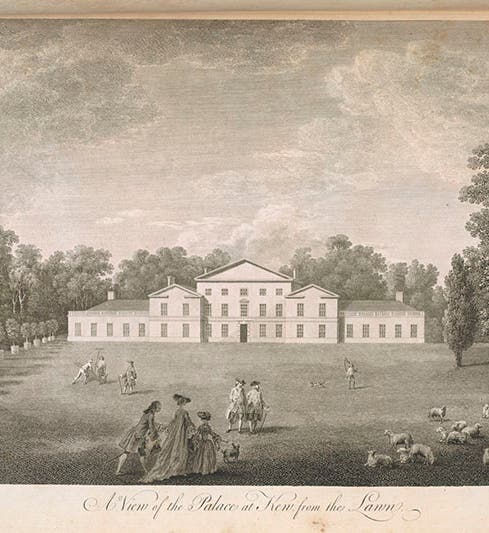Scientist of the Day - Samuel Molyneux
Samuel Molyneux, an Irish politician and amateur astronomer, was born July 16, 1689. Molyneux was a member of a scientifically inclined Irish family; his father and uncle, William and Thomas, played an instrumental role in inaugurating geological study of the Giant’s Causeway, the now-famous basalt formation in northern Ireland. But Samuel liked telescopes – he liked building them, and he liked using them. He knew that Robert Hooke had tried to detect stellar parallax, the tiny annual motion that stars should exhibit if the earth moves around the sun, in the 1670s. Hooke thought he observed parallax, but he didn't. Molyneux thought he (Molyneux) could, if he had a better telescope. So he commissioned a zenith sector – a telescope that looks straight up – from a noted English instrument maker, George Graham, and he enlisted the help of James Bradley, an up-and-coming astronomer whose expertise would prove essential. The telescope was 24 feet long, and for most amateur astronomers, mounting it vertically would be a problem. Fortunately, Molyneux had married the daughter of the 2nd Earl of Essex, and she inherited a splendid palatial home in what is now Kew Gardens. It was then known as Kew House (first image, above), and here Molyneux was able to mount his zenith telescope.
Bradley and Molyneux began their work in 1725, and they never did observe stellar parallax – it was too small for even their instrument to detect. But they did observe another unexpected slight annual motion of their target star, known as gamma Draconis. Bradley ultimately realized that it was a result of the fact that light moves with a finite speed, so that if the earth is moving across the path of the light, the result is a slight sideways deflection of the light. He called this new phenomenon the "aberration of light," and he announced it in a paper of 1729. It was one of the very first proofs that the earth moves through space. It is unfortunate that Molyneux, who should have shared in the approbation, had collapsed and died the previous year, at the age of only 38. Molyneux’s original telescope has disappeared, but Bradley ordered another from the same instrument maker for himself, just 12 feet long, and that one does survive, in the National Maritime Museum (second image, below). We have already written a post on Bradley, where you may see a different view of the same zenith sector.
Molyneux spent his last three years in a variety of political positions that left him little time for astronomy, which spurred Bradley to buy his own instrument and arrive at the aberration of light on his own. Molyneux was a Member of Parliament from 1726 on, was secretary to George, Prince of Wales (a position he had taken on in 1715), and he also became a Lord of the Admiralty in 1727. In 1726, the Prince of Wales asked Molyneux to look into the case of a woman of Surrey, named Mary Tofts, who claimed to have given birth to quite a few still-born rabbits. Molyneux was accompanied in his on-site inquiries by Nathaniel St André, a Swiss physician at the Royal Court. Molyneux's opinion of the affair is not clear, but St André was thoroughly convinced that the bunny deliveries had actually occurred, and when it was soon exposed as a hoax, St Andre fell from royal favor, and Molyneux was tarnished by association, although it did not prevent his being appointed a Lord of the Admiralty.
And when Molyneux collapsed in the House of Commons in 1728, he was attended to by none other than his collaborator in the leporine affair, St André, who accompanied him to Kew House, where Molyneux died several days later. The night of his death, St André ran off with Molyneux's wife Elizabeth, whom he eventually married in 1730. The two were charged in print by a Molyneux relative with conspiring to murder Molyneux, but nothing came of it, except that St André now had ownership by marriage of Kew House, if only briefly. The house, however, was soon acquired by the new Prince of Wales, Frederick, the son of George II, who had the house enlarged and whitewashed, so that it became known as the White House at Kew. When the Prince died unexpectedly in 1751, his wife continued to live there, and it became known as the Princess Dowager House, and it was she who, in 1757, began the transformation of the gardens into what is now Kew Gardens. The house where Bradley and Molyneux made their initial observations, and which went through so many transformations and name changes after 1730, was torn down in 1802. There is a sundial made by John Bird that marks the former spot of Kew House (third image, below), but it is only a replica, and, as far as I know, there is no mention of Samuel Molyneux to be found anywhere on the grounds.
If a portrait of Molyneux survives, I was unable to locate it.
Dr. William B. Ashworth, Jr., Consultant for the History of Science, Linda Hall Library and Associate Professor emeritus, Department of History, University of Missouri-Kansas City. Comments or corrections are welcome; please direct to ashworthw@umkc.edu.






![Using an astrolabe to measure the depth of a well, woodcut in Elucidatio fabricae vsusq[ue] astrolabii, by Johannes Stöffler, 1513 (Linda Hall Library)](https://assets-us-01.kc-usercontent.com:443/9dd25524-761a-000d-d79f-86a5086d4774/a998eb50-55d2-4a88-ace2-a50aa5fa86e7/Stoffler%201.jpg?w=210&h=210&auto=format&fit=crop)

